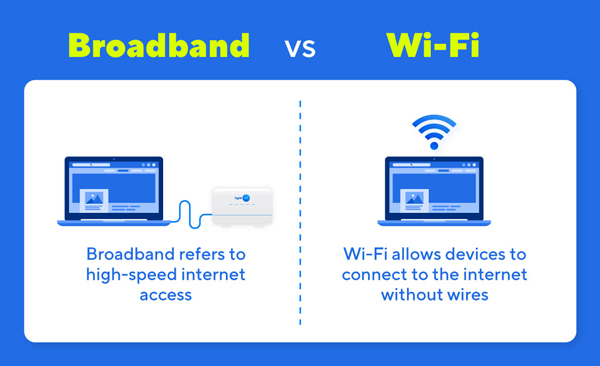What Is the difference between broadband and Wi-Fi? |

Are they the same?
We’ve all heard the terms Wi-Fi and broadband, but what are they, what makes them different, and is broadband Wi-Fi?
In short, no. Broadband and Wi-Fi are not the same. Wi-Fi is a wireless connection between multiple devices and your router, and just one of the ways you can access the internet. Broadband is the actual internet connection afforded by your internet service provider (ISP), which you can access directly via a LAN or ethernet connection between your modem and device.

The main differences between broadband and Wi-Fi are:
| Broadband: | Wi-Fi: |
|---|---|
| A high-speed, always-on internet connection | A wireless networking technology that uses radio waves to connect a router to multiple devices |
| Can connect as many devices as your modem has LAN ports to the internet directly (usually 3-4) | Can connect multiple devices wirelessly to the router, and by extension, the internet |
| People around the country and globe can connect to broadband through wire, satellite, or mobile services like 4G and 5G | A limited amount of devices can share a Wi-Fi network connection (around 250) |
| There is no authentication system | Passwords and other means of authentication can ensure limited access to your Wi-Fi network |
Broadband is the direct connection between your home and the internet. Your modem or modem router works as a receiver and allows you to connect to the internet provided by your ISP. It is essentially a high-speed internet connection that’s always live.
However, a broadband connection can come in many different forms. Your home may be connected via ADSL (asymmetric digital subscriber line), fibre optic, satellite, or a mobile service like 4G.
- ADSL is one of the most common types of broadband in the UK. It connects using the copper wires found in phone lines already present in most homes. This makes it easy to install, but it can be much slower than the alternatives.
- Fibre optic is one of the most recent types of broadband. Rather than copper, it uses thin plastic or glass cables, which enables information to be transmitted much more quickly. This technology has created incredibly fast internet access. If you have fibre optic available, you may want to consider if you would prefer super-fast vs ultra-fast broadband, depending on how much you value upload and download speed.
- Satellite broadband is a type of connection provided by low Earth orbit or geostationary satellites. Those in rural areas where traditional cables may not reach can make use of this type of technology. It is often much more expensive than ADSL and fibre, but can offer similar download and upload speeds. Another difference is that your modem will connect by wire to a satellite dish, rather than by a cable.
- Mobile services like 4G and 5G are a relatively new type of broadband. These allow you to gain internet access without the use of cables or a phone line. Instead, they use the same signal your mobile phone receives. Mobile services can be significantly faster than ADSL in regions with 5G coverage, but rural areas will likely receive a slower or comparable speed.
It is not simply technology that defines broadband. Some regulators also define it by speed. For example, Ofcom, the communications industry regulator, defines 10Mbps download and 1Mbps upload speeds as broadband.
Pros and Cons of Broadband
| Pros: | Cons: |
|---|---|
| A broadband connection is much faster than traditional dial-up | There is usually a monthly cost associated with broadband that varies by ISP |
| The connection itself is more reliable than dial-up | Any complications with the ISP may result in a loss of connection |
| There is no authentication process, which means you can plug in and be online | There is no authentication process, which means anyone can connect without a password, increasing the risk of being hacked |
| Broadband will cause no interruptions to your phone line | Rural areas may find little to no coverage from wired broadband and be forced to use more expensive satellite or mobile services. |
While broadband may be the reason you can connect to the internet, a local Wi-Fi network allows you to connect multiple devices simultaneously. Wi-Fi cannot connect to the internet on its own, but it can create a local network that connects to your router. This enables an internet connection without the use of a wired ethernet cable.
With Wi-Fi, you can connect your phone, smart TV, laptop, or any other internet-compatible devices, all at the same time with a minimal loss of speed. The current iteration is Wi-Fi 6, as decided by the IEEE (Institute of Electrical and Electronics Engineers) standard for wireless local-area networks.
The main benefit of a Wi-Fi network is that it allows you to take a device from one room to another while maintaining a connection to the internet – as long as you are within range of your router.
The best place to put your router will depend on the size of your house. Larger houses may require boosters to ensure your Wi-Fi network covers the entire home. Bear this in mind if you move broadband when you move house because ISPs provide their own routers that could have different ranges.
Pros and Cons of Wi-Fi
| Pros: | Cons: |
|---|---|
| Increased security against hackers due to the use of authentication and passwords | Public Wi-Fi networks are more vulnerable to hackers |
| A single router and Wi-Fi connection can often reach every room in the house | The range of the network is limited to around 150m, meaning boosters may be required if you live in a large home |
| Multiple users and devices can connect at the same time | Wireless connections are generally slower than wired ethernet connections |
| There is no need for an abundance of wires to be used to connect to every device since it is all wireless | The bandwidth of the network becomes weaker as more devices are added |
While it’s difficult to directly compare Wi-Fi and broadband, since they accomplish two different tasks, it is safe to say that broadband is typically a better, more secure connection because it is direct.
A broadband security checklist can be used to prevent malware and viruses, by helping you understand how these threats can target your Wi-Fi network. Since Wi-Fi is an additional step to getting online, it may increase the number of overall threats you receive. Remove that step and the connection becomes faster and safer.
Wi-Fi is great if you want to connect multiple devices simultaneously, without the use of wires. But, it requires a broadband connection to do anything besides sharing data between devices.
Connection to the internet requires an ISP-provided broadband. The benefit of this is that you can always get Wi-Fi at a later date if you find you are using more devices than you initially thought you would.
A combination of both may be best for your household, but if you had to choose, broadband should be the winner.
There is some confusion about the difference between broadband and Wi-Fi. Broadband cannot be used as Wi-Fi because a wire is usually required to connect to it directly, whereas a Wi-Fi network uses radio waves and is wireless. With that said, they are not mutually exclusive. Wi-Fi is just one of the ways you can access your broadband.
Wireless broadband, as provided by mobile services like 4G, is wireless as its name implies, but acts in a different way to Wi-Fi. It uses a mobile phone network to connect to the internet, but generally still requires a router to access. This router may then have its own Wi-Fi network, which will allow you to connect multiple devices.
Fixed Wireless Access (FWA) is another newer form of broadband without a phone line. Instead, it transmits radio waves between two fixed points – a rooftop antenna and a base station. Usually, one point will be fixed in a similar way to a satellite dish, so it doesn’t rely on fixed wires or cables.
This means internet service providers can offer ultra-fast broadband to rural and suburban homes, without the fees associated with laying and maintaining miles of cable. The cost of this can be so high that government-backed schemes, like Project Gigabit, have been implemented to provide the country with the infrastructure needed for widespread fibre optic broadband. This is especially important because high-speed broadband is to become a legal right.
5G Fixed Wireless Access is an example of this technology and can provide a comparable bandwidth speed to fibre optic broadband. These high speeds are required to support certain high-definition streaming services and ultra-fast internet access.
Regardless of how you get your broadband, it’s important to find an internet service provider offering the most value for your money. Hyperoptic’s mission is to offer everyone in the UK ultra-fast, reliable fixed-fibre broadband for an affordable price.
Broadband costs can vary hugely. Browse our full fibre broadband deals to discover the option that’s best for you, or see if you are eligible to switch broadband providers.
We also have packages tailored for specific users like Wi-Fi student broadband deals.
Check out our full fibre broadband packages |

Most popular FAQs
Which connection is best for the internet?
Broadband is the best connection for the internet, in terms of speed and safety. While fibre optic remains the most reliable type of broadband, with advances in 5G technology, it won’t be long before there is competition.
Which type of Wi-Fi is best for home?
Wi-Fi 6 is the best and latest version of Wi-Fi and is backwards compatible with most routers. However, to make the most of it, newer router models may be required.
Can you have Wi-Fi without broadband?
You can create a Wi-Fi network and connect multiple devices together without broadband. But, you will be unable to connect any of them to the internet.
What is the fastest Wi-Fi for home?
Wi-Fi technically isn’t the reason you experience slow internet. Often, decreased speed is a result of your broadband provider experiencing difficulties. Therefore, you should look out for the fastest, most reliable broadband deals, rather than the fastest Wi-Fi.
Providers can also have different deals tailored for specific users such as our student broadband deals.
What should I look for when buying Wi-Fi?
Look for internet service providers advertising ultrafast broadband. Most ISPs offer their deals with a router modem included, which will give you access to super-fast Wi-Fi too.
It can also be helpful to look out for special deals. Some providers offer better rates for certain groups of people, like with student broadband deals
What are the types of Wi-Fi?
There have been 6 iterations of Wi-Fi, with Wi-Fi 6 being the latest. They used to be classified by a number and letter system, where variations of “802.11 ax” denoted the iteration. This was simplified to be more in line with the numbering system of mobile services (3G, 4G, and 5G) to improve public understanding of the technology.





